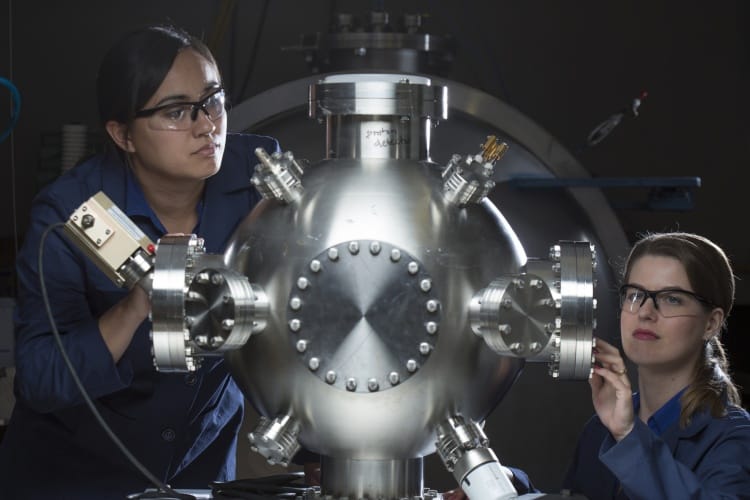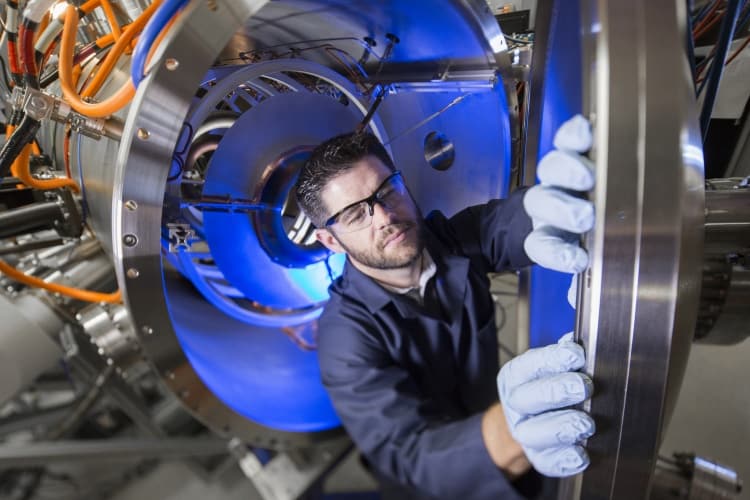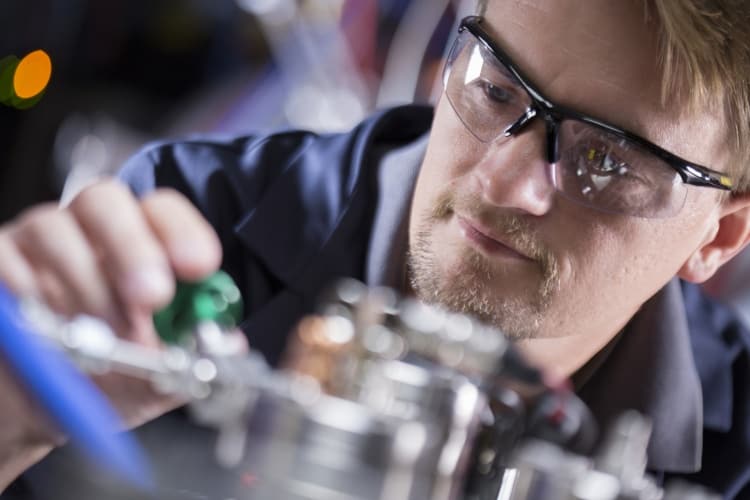After surprising the world with the announcement of a new nuclear fusion energy concept with the possibility of fast application at relatively low cost, Lockheed Martin has revealed more detail about the basis of its proposed compact fusion reactor (CFR). Research leader Tom McGuire of the Revolutionary Technology division of the company’s Skunk Works research base admitted that the project is four years into its progress and is still at a very early stage, and explained some of the areas where he is looking for collaborations to take the research forward.
In a telephone press conference, McGuire explained that the CFR borrows design aspects of a number of fusion concepts which in previous years have failed to fulfil their potential. Its key aspect is that it is small, ‘a few metres in diameter’, rather than the 16m radius of the ITER tokamak, the doughnut-shaped experimental reactor currently taking shape in France. ‘What’s really exciting is that we can develop it more quickly because of its scale,’ he said. ‘One of the powerful things about that is that we can start working on a full scale prototype more quickly, and in the future it cuts down the huge capital costs.’

Nuclear fusion works by stripping away electrons from atoms of two heavy isotopes of hydrogen, deuterium and tritium, and confining the gaseous mixture of the positively-charged atomic nuclei, called a plasma, into a small space. The plasma then has to be heated to make the nuclei travel fast (in a gas, temperature is another way of expressing particle speed); this is necessary because the particles are all positively-charged and need to be moving fast to overcome electrostatic repulsion and collide.
”What’s really exciting is that we can develop it more quickly because of its scale; we can start working on a full scale prototype more quickly, and in the future it cuts down the huge capital costsTom McGuire
If they collide hard enough, they undergo fusion, transforming into the nucleus of a helium atom and spitting out an excess neutron, whose extremely high velocity can be captured as energy by slowing it down. Transferring this energy to a coolant would allow it to be used to generate electricity. The energy released by fusion is huge; it powers the sun, and only a small amount of deuterium and tritium would be needed to match the performance of a conventional nuclear reactor, but without the waste and with much lower risk of harmful radiation.
McGuire’s reactor traps the plasma using powerful magnetic fields. Unlike a tokamak, which wraps its plasma in a complex series of fields made by three sets of huge magnets outside the reactor vessel, the CFR has two sets, one inside consisting of two rings suspended in the plasma and one outside, circling the circumference of the cylindrical reactor. The internal magnets produce a type of magnetic field known as a diamagnetic cusp, where the magnetic forces change direction rapidly and force the nuclei in the plasma towards the midpoint between the two rings (this is called a magnetic well). The fields from the external magnets squeeze the plasma, forcing it towards the ends of the vessel, while the two magnets at either end produce a very high magnetic field which acts as a mirror, forcing the particles back into the reactor in a process known as ‘recirculation’. ‘Part of what we’re doing is to probe the properties of that and look at our diamagnetic shape and confinement and see if really works at lower temperature, and as we go forward we’ll increase heating and scale it up,’ McGuire said.
”Much like the first jet engine was very crude but extremely effective, we’d want to follow the same path that gets something out and then iterate again and again to a powerful solution
Cusp reactors, magnetic mirrors and recirculation have all been investigated before in reactors called polywells and field-reversed configuration reactors (FRCs) but without the benefit of superconducting magnets. These take advantage of the behaviour of some electrical conductors at very low temperatures to allow electricity to flow with no resistance. This allows very strong magnetic fields to be created without the need for a great deal of energy. Also, McGuire says, the way the team combines the design elements is new.

The research is currently at a point of investigating the physics of the plasma’s behaviour. There are important differences between this reactor and a tokamak; the latter uses its magnets to set up a strong electrical current in the plasma itself to heat it up, while the CFR has no net current. ‘This eliminates the prime driver for instabilities,’ McGuire explained in email correspondence. The favourable surface-to-volume ratio of the plasma means that the CFR can achieve much better confinement in comparison to other mirror concepts,’ he added.
The small volume of the plasma means that less energy is needed to heat it to the point where fusion occurs, McGuire said. In experiments, the team is using microwave emitters to pump energy in to initiate fusion, but for a working reactor he expects to use the technique of neutral beam injection, where very fast uncharged deuterium atoms shed their energy in the plasma; the build-up of heat from fusion will then be sufficient to keep the reaction going. Despite this, the ratio of the plasma pressure to the pressure exerted by the magnetic field - a property known as beta - is much higher than in tokamaks, by a factor of ten. This means more plasma, more fusion reactions, and more energy output.
Among the current research problems is protecting the magnets within the plasma. Fusion bombards these with neutron radiation, which can damage many materials, and the temperature of many millions of Kelvin in the reactor is also difficult, as the magnets have to be kept just above absolute zero to maintain superconduction. ‘The detailed design of the shielding hasn’t been done yet; it could be 80-150cm thick depending on the technology,’ McGuire said. ‘But even in the most conservative case, the reactor would still be small enough to be feasible.’
Another area where more work is to be done is on the ‘blanket’ component which lines the reactor vessel. This has two functions: it captures the fast neutrons and transfers their energy to a coolant, which McGuire thinks would probably be a liquid metal; and it also forces the neutrons to collide with lithium atoms, transforming them into tritium to fuel the reactor. ‘We’ve done feasibility analysis to show we can protect the structures and we have a path to follow,’ said McGuire. ‘In coming years we have a lot more work to do on refining and giving some options. You have different design requirements for a mobile application and a ground application in terms of radiation and lifetime performance.’ The idea is that the blanket would provide all the neutron radiation shielding needed to make the CFRs safe to work with; this could mean the reactor would weigh anything from 300-1000tonnes.

The Skunk Works team is already thinking about how the reactor could be applied. ‘We want the path going forward to be feasible, otherwise we wouldn’t be doing this,’ McGuire commented. Static applications, which would see the reactor loaded into shipping containers and taken to existing power stations where the heat exchangers would be used to power gas turbines, replacing combustion units, is one possibility; mobile applications such as shipboard power are another; they could even power aircraft, although McGuire conceded that this would be ‘one of the more difficult ones’.
”We are not naïve about this; we know that there’s a significant engineering and materials science challengeRay Johnson, Lockheed Martin CTO
The need for collaboration is the main reason Lockheed Martin released information on the CFR so early, said company chief technical officer Ray Johnson. ‘We are not naïve about this,’ he said. ‘We know that there’s a significant engineering and materials science challenge, and things that are discovered on the way have to be solved. We also know that partnerships with the best & brightest in industry and academia are critical to advancing this concept further and that’s why we decided to go public with our efforts now.’
McGuire’s team has applied for three patents for their design. ‘We’ve run 200 shots in the commissioning phase, we’re planning to take a full set of diagnostic data and publish that in conferences next year,’ he said. ’We’re also working on a series of more high-fidelity simulations, which we’ll publish as well in the coming year.’
The team’s approach is to find working versions of each part of the system, starting with full-scale plasma confinement, then iterate on their equipment to come up with a fully-working prototype. ‘We think the materials are good enough for a first iteration and it will only get better with time,’ he said. ‘Much like the first jet engine was very crude but extremely effective, we’d want to follow the same path that gets something out and then iterate again and again to a powerful solution.’ The first prototype can therefore be expected to be very different from a production model.
This article has been edited to remove an erroneous claim that McGuire’s team had achieved ignition - self-sustaining fusion requiring no external energy input - with less than a kilowatt of initial heating. This resulted from a misunderstanding during the telephone press conference.










UK Enters ‘Golden Age of Nuclear’
Apologies if this is a duplicate post - a glitch appears to have removed the first one: > While I welcome the announcement of this project, I note...